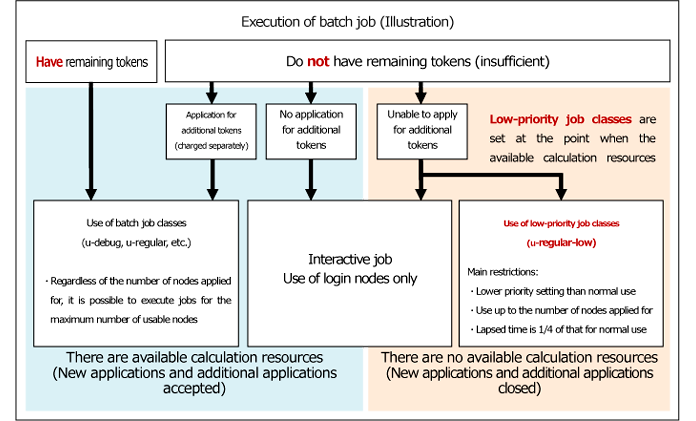Low-priority job classes
» Click here for “Job classes” » Click here for “Courses”
Under the Reedbush Supercomputer System, in cases where the available calculation resources (tokens) have been exhausted and new applications for additional tokens are not accepted, an environment that enables job execution is provided to group and personal course user who have finished using their tokens.
Setting of low-priority job classes (low-priority queues)
Under the Reedbush Supercomputer System, tokens are consumed each time a job is executed. Hence, in cases where there are no tokens left or insufficient tokens for a job at the point of job execution, it will no longer be possible to execute the job. At this point, it will be possible for the user to apply for additional tokens if applications have not yet been closed when available calculation resources run out. However, tokens cannot be added after the application deadline. In such situations, even when there are no remaining tokens or insufficient tokens, low-priority job classes (low-priority queues) are provided. This is a job-execution environment with lower priority than usual, but which enables the execution of jobs only when there are spare resources available. (Use of interactive jobs and login nodes is possible under current conditions.)
Low-priority job class setting (provision): Illustration

Restrictions of low-priority job classes (low-priority queues)
This system allows group and personal course users who have finished using their tokens to execute jobs, so job execution for such users is set to lower priority than users with tokens. For that reason, it differs from normal use in the following aspects.
- It is established as a measure after the application deadline has passed, due to the exhaustion of available calculation resources. For that reason, in cases where the addition of tokens is possible, please note that the operation of low-priority job classes will not be carried out.
- The maximum number of nodes and limiting (lapsed) time for a single job are lower than for regular use.
- The number of jobs that are executed simultaneously under low-priority job classes (low-priority queues) is set as “1” for each queue (the number of jobs that can be submitted for each queue and each user is up to “2”). However, in cases where there are spare calculation resources, the number of jobs that may be executed simultaneously can be changed.
- Job interruption by normal job classes may occur. Please note that the scheduled date and time for job execution, displayed through the “rbstat” command, may change at any time.
- It does not necessarily mean that a job will be executed as long as there are free calculation resources. There are cases where execution of a new job is prevented while the flow of jobs is adjusted.
- There are cases where use through public applications (corporate use, youth/female user recommendations, HPCI/JHPCN), etc. is not accepted for this system.
Reedbush-U System: Low-priority job class limiting values
Note: Operation for Reedbush-U has been terminated. (June 30, 2020)
| Queues | Number of nodes | Limiting time (time lapsed) | Memory (GB) |
|---|---|---|---|
| (u-regular-low) u-small-low u-medium-low u-large-low u-x-large-low |
4 ~ 16 17 ~ 32 33 ~ 64 65 ~ 128 |
12 hour 12 hour 12 hour 6 hour |
244 244 244 244 |
- The number of nodes that can be used is up to the number of nodes applied for in the group course, and up to 4 nodes in the personal course.
- There are two methods for submitting jobs: by assigning “u-regular-low” (routing queue) and by directly assigning a separate queue. For separate queue, each user may submit up to two jobs. For “u-regular-low,” when the third job assigned to a specific queue is retained and cannot be submitted to another queue, please either delete the retained job or submit it directly to a separate queue.
Reedbush-H System: Low-priority job class limiting values
| Queues | Number of nodes | Limiting time (time lapsed) | Memory (GB) |
|---|---|---|---|
| (h-regular-low) h-small-low h-medium-low h-large-low h-x-large-low |
1 ~ 4 5 ~ 8 9 ~ 16 17 ~ 32 |
12 hour 12 hour 12 hour 6 hour |
244 244 244 244 |
- The number of nodes that can be used is up to 1/4 of the number of nodes applied for in the group course, and up to 1 node in the personal course.
- There are two methods for submitting jobs: by assigning “h-regular-low” (routing queue) and by directly assigning a separate queue. For a separate queue, each user may submit up to two jobs. For “h-regular-low,” when the third job assigned to a specific queue is retained and cannot be submitted to another queue, please either delete the retained job or submit it directly to a separate queue.
Reedbush-L System: Low-priority job class limiting values
| Queues | Number of nodes | Limiting time (time lapsed) | Memory (GB) |
|---|---|---|---|
| (h-regular-low) l-small-low l-medium-low l-large-low |
1 ~ 4 5 ~ 8 9 ~ 16 |
12 hour 12 hour 12 hour |
244 244 244 |
- The number of nodes that can be used is up to 1/4 of the number of nodes applied for in the group course, and up to 1 node in the personal course.
- There are two methods for submitting jobs: by assigning “l-regular-low” (routing queue) and by directly assigning a separate queue. For a separate queue, each user may submit up to two jobs. For “l-regular-low,” when the third job assigned to a specific queue is retained and cannot be submitted to another queue, please either delete the retained job or submit it directly to a separate queue.
